Driving to Villarrica felt like coming home. A few years back, several TBF members spent a month here studying the behaviour of its lava lake. Back then we had to face a series of storms and found ourselves working under the snow and having to dig out our instruments from piles of ice every other morning. The lake level was very low, the gas emissions barely above detection limit and the resulting data not amazing.
This time we were welcomed with a pure blue sky, little wind and a beautiful high stand of the lava lake! Spattering could be seen from the rim. Using quadcopters, we collected gas composition information, put together 3D models, and filmed the extremely dynamic lake.
Our colleague Ashley Davies at JPL acquired a satellite image using the NASA Volcano Sensor Web looking straight down the barrel of the vent. On the left, an image taken using visible light reveals a regular looking cloudy and snow capped volcano. But on the right, the shortwave infrared reveals the glow of the lake at the summit.
EO-1 image acquires on the 16th Januray 2016. The Earth Observing-1 (EO-1) spacecraft is managed by NASA's Goddard Space Flight Center, Greenbelt, Maryland. EO-1 is the satellite remote-sensing asset used by the EO-1 Volcano Sensor Web (VSW), developed by NASA's Jet Propulsion Laboratory, Pasadena, California, which is being used to monitor volcanic eruptions around the world.
Quite a few things had changed since our last visit. In March 2015 a very impressive eruption shook the volcano, with lava fountains higher than a kilometre. As a result, the summit area is quite different, breached by a new, still steaming lava flow. The walk up over the glacier however has remained unchanged, and so has the way down, sliding on custom-made cardboard sledges!
Driving south from Nevados de Chillán, we followed Pan America Highway - Ruta 5 - down the Chilean central valley between the Andes and a second parallel range of mountains along the coast, the Cordillera de la Costa. The valley and coastal mountains exist partly due to the weight of the Andes flexing the Earth’s crust, and partly due to marine sediments being scraped off the Nazca plate as it slides into the Peru Chile Trench. Luckier sediments make it down the trench and are squeezed and baked until they release their volatiles which work their way up and out of the bowels of the Earth and into our Delta Ray. Other sediments have to settle for becoming mountains instead. Villarrica lies at the northern end of the Chilean ‘Lake District’, a region of towering snow capped mountains, dense forests and crystal clear lakes. These lakes increase in size and frequency heading south, until the valley runs out of land altogether and becomes the floor of the fjords of Patagonia. But more on that later. By this point we had been on asphalt so long that our Land Rover started complaining of the lack of challenges… We eventually took it back on some dirt track on the volcano flank until we found the best place to deploy our remote sensing gear.
Villarrica is one of only five lava lakes world-wide. Lava lakes are in some sort our team’s sub specialty -- TBF members have nearly all done their thesis on Lava lakes, in Ethiopia (Erta Ale), Antarctica (Erebus) and Vanuatu (Ambrym). Lava Lakes always feel special for us and we decided to spend a bit longer at Villarrica, ascending it multiple times and acquiring long time-series.
We did eventually have to leave what will long remain one of our favourite volcanoes… The Trail must go on!




















